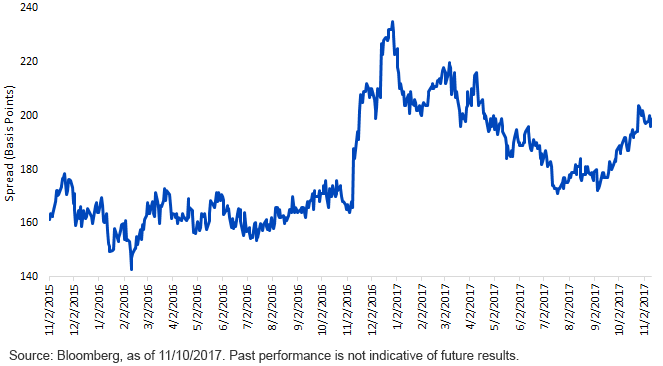Thus far, 2017 has proved to be somewhat of a vexing year for investors expecting to see a higher U.S. rate environment. While the Federal Reserve (Fed) has delivered on its front by pushing up short-term interest rates, longer-dated yields such as the U.S. Treasury (UST) 10-Year note have not followed suit. I like to think of developments for the UST 10-Year yield as a three-legged stool consisting of the “Trump reflation trade,” inflation expectations and the Fed policy outlook. However, there is a fourth element that has gone a bit under the radar, and that is the continued yield advantage UST securities enjoy as compared to their developed world counterparts, namely the German bund.
Certainly, when the UST 10-Year yield was falling to all-time lows in mid-2016, the general consensus was that this yield advantage was playing an integral role—namely that global investors were buying Treasuries over other developed world government debt. Then a funny thing happened: the U.S. election, which led to all three legs of the aforementioned “stool”’ working to push the UST 10-Year yield higher. Another key aspect that occurred simultaneously was that the spread between the 10-Year UST and the 10-year bund widened even further, moving out to readings not seen since 1989. However, unlike the pre-election experience, this “new” and even more favorable yield advantage was essentially being ignored.
U.S. 10-Year vs. 10-Year German Bund

It may have taken global bond investors awhile, but it appears as if this factor is, once again, playing an important role in the latest UST 10-Year yield developments. Despite the fact that there have been reports of outflows in longer-dated Treasuries, UST yields have managed to stay in a range of roughly 10 to 15 basis points (bps) over the last month or so. After reaching a recent peak of +235 bps in late December, the UST/German bund 10-year spread narrowed by more than 60 bps in late summer but has since reversed course and pushed upward to the +200 bp threshold of late. At this level, the differential is now nearly 60 bps above the two-year low water mark and has apparently spurred bond investors into action.












Leave A Comment